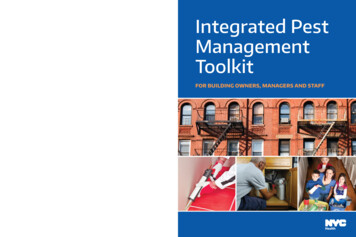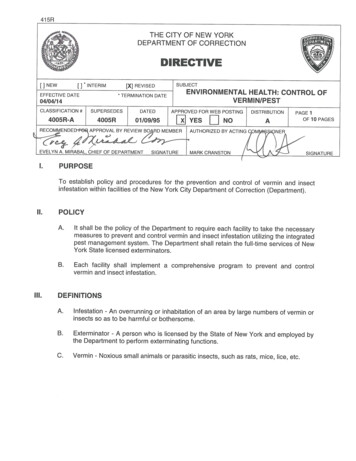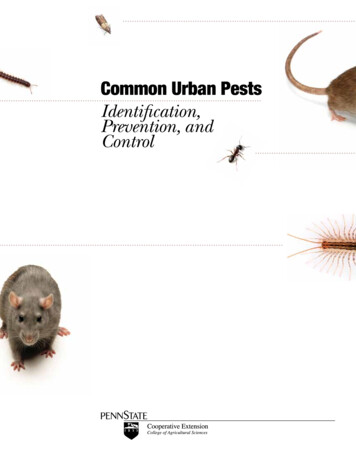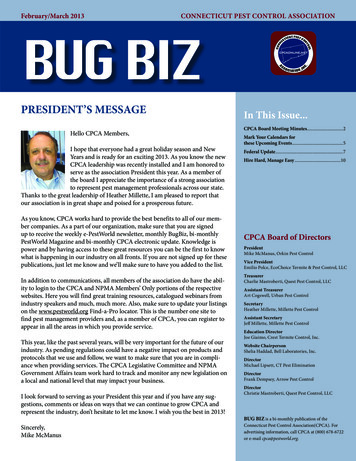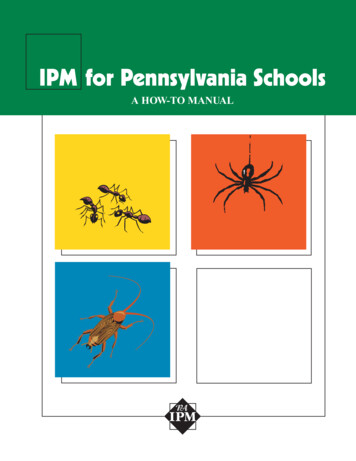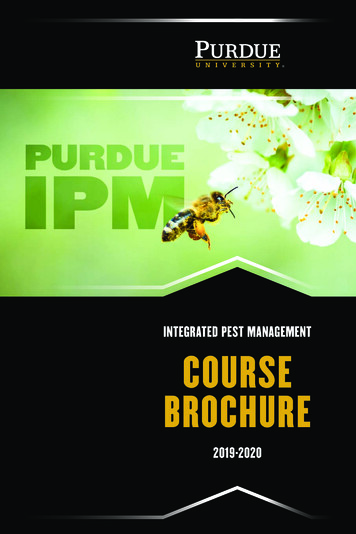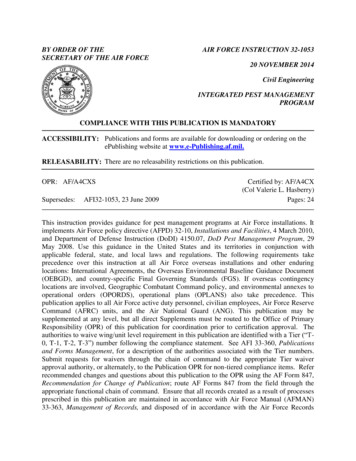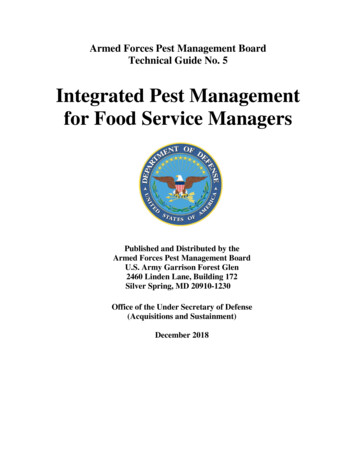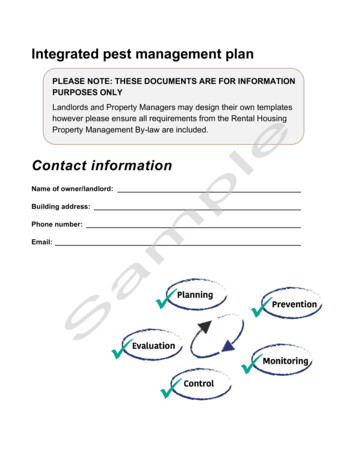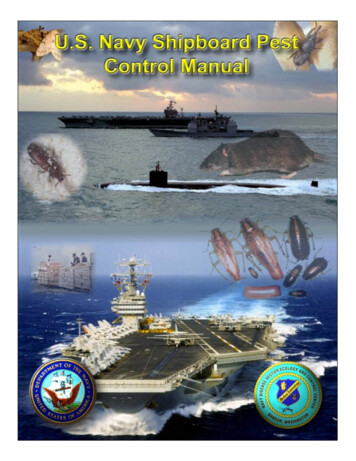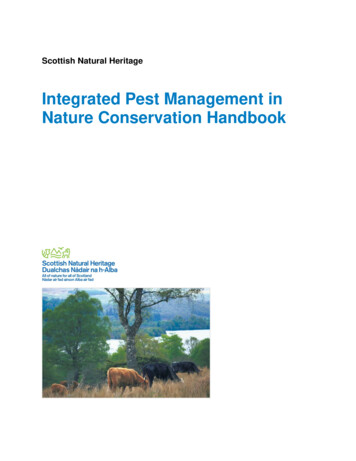
Transcription
Scottish Natural HeritageIntegrated Pest Management inNature Conservation Handbook
Edited by SNHPrepared by:Sarah Cook, Steven Tompkins & Nigel CritchleyADAS UK LtdBattlegate RoadBoxworthCambridge CB23 4NNYear of publication: May 2014(Partially edited in 2018 with removal of contents on herbicides)It is the responsibility of the user to check that any plant protection products listed remain and are fullyauthorised for use. Our guidance is not legally binding nor does it constitute an open ended endorsementof a particular product or chemical, it is intended for guidance only and it is the end users’ responsibility tocheck before use on the status of any products.
ContentsPart 1IPM in nature conservation1.1Introduction . 51.2Vegetation, pest and disease management . 81.3IPM Framework . 12Part 2Protocols for Invasive Non-native Species2.1IPM protocol for the control of Japanese knotweed (Fallopia japonica). 162.2IPM protocol for the control of giant hogweed(Heracleum mantegazzianum). 222.3IPM protocol for the control of Himalayan balsam (Impatiens glandulifera) . 292.4IPM protocol for the control of freshwater macrophytes . 35Part 3Protocols for the management of other species3.1IPM protocol for the control of creeping thistle (Cirsium arvense) . 483.2IPM protocol for the control of ragwort (Senecio jacobaea) . 543.3IPM protocol for the control of bracken (Pteridium aquilinum) . 623.4IPM protocol for the control of rushes (Juncus spp.) . 703.5IPM protocol for the control of purple moor-grass (Molinia caerulea)on heather moorland . 763.6IPM protocol for the control of scrub . 82Part 4Other pest, disease and vegetation management4.1Vegetation management around visitor facilities . 894.2Forestry . 93Appendices1.Legislation for chemical control . 962.Herbicide application methods. 1013.Example of an IPM process . 107Integrated Pest Management in Nature Conservation3www.snh.gov.uk
Part 1IPM in nature conservationIntegrated Pest Management in Nature Conservation4www.snh.gov.uk
1.1 IntroductionOver recent years the quantity of pesticides used in agriculture and forestry hasreduced, and many of the more toxic and environmentally damaging products havebeen withdrawn. In nature conservation, non-chemical control of weeds, pests anddiseases has usually taken priority and pesticide use has always been low, butoccasionally there is a need to apply a pesticide for ecological gain. Recent EUlegislation requires that the conditions are created for the implementation ofIntegrated Pest Management (IPM) principles by all professional users ofpesticides and that pesticide use is minimised in protected areasThe aims of this handbook are to:1. present Integrated Pest Management (IPM) principles in the context of natureconservation;2. encourage site managers to adopt an IPM approach to minimise use ofchemicals and protect the environment;3. provide a set of protocols and sources of further information for specific issuesmost commonly encountered in Scotland; and4. provide the basis for making decisions about non-chemical and chemicaloptions for control.1.1.1 EU and UK legislationThe Sustainable Use Directive (2009/128/EC) was published in November 2009and came into effect on 14 June 2011. The directive sets a framework forCommunity action to achieve sustainable use of pesticides. One of therequirements is to take all necessary measures to promote low pesticide input pestmanagement, where priority should be given to non-chemical methods. Thedirective states that government should: establish, and support the establishment of, the conditions needed to implantIPM; ensure general principles of IPM are implemented by all professional users by2014; and ensure that the use of pesticides is minimised or prohibited in certain specificareas, which includes protected areas.‘Pest’ in Integrated Pest Management refers to all harmful organisms includingpests (e.g. insects), diseases and weeds.The Directive was transposed into UK legislation on 18 July 2012 when the UKPlant Protection Products (Sustainable Use) Regulations 2012 came into force.Integrated Pest Management in Nature Conservation5www.snh.gov.uk
1.1.2 Principles of IPMIntegrated pest management (IPM) has its origins in horticulture and agricultureand is part of the conceptual framework for Integrated Production (IP). Thisconcept was developed in 1976 by the International Organisation for Biological andIntegrated Control of Noxious Animals and Plants (IOBC). The concept is basedon the use of natural resources and regulating mechanisms to replace potentiallypolluting inputs. Preventive agronomic measures and biological/physical/chemicalmethods are carefully selected and balanced taking into account the protection ofhealth of users, consumers and the environment. The principles and objectives ofIP can be found in Boller et al (2004).IPM is not an off-the-shelf package but is an approach that is knowledge intensive,emphasising the importance of expertise and knowledge about ecological andbiological systems dependent upon local conditions and the cropping situation.Prevention is highlighted, stressing the need to grow a healthy crop using resistantvarieties, maintaining a fertile soil and nutrient balance and ensuring the presenceof natural enemies.The use of pesticides ranges from minimal use, to biopesticides, selectivepesticides over broad spectrum, and quickly degradable pesticides over persistentones.The Food and Agriculture Organisation has proposed the following definition (FAO,2011):’Integrated Pest Management (IPM) means the careful consideration of allavailable pest control techniques and subsequent integration of appropriatemeasures that discourage the development of pest populations and keeppesticides and other interventions to levels that are economically justified andreduce or minimize risks to human health and the environment. IPMemphasizes the growth of a healthy crop with the least possible disruption toagro-ecosystems and encourages natural pest control mechanisms.’In sites managed for nature conservation, the main objective will be themaintenance and enhancement of the particular features of conservation interest.Although the principles of IPM were developed for horticulture and agriculturewhere the main objective is crop production, many of the same principles can alsobe applied at sites where nature conservation is the primary objective.1.1.3 About this guideA general framework is provided showing the stages to be followed in implementingIPM in nature conservation. A series of protocols follows along with a workedexample, which can be used to make decisions about the optimum IPMapproaches for particular weed or vegetation management issues, and draws onexisting guidance. The protocols are not meant to replace detailed guidancedocuments on vegetation management or herbicide use, which remainessential reading, but to complement these by providing an IPM framework.Links to available guidance are provided.The general framework could also be used to produce a protocol or pestmanagement plan for individual circumstances, including additional organisms notcovered in this handbook.Integrated Pest Management in Nature Conservation6www.snh.gov.uk
The availability and approval of herbicides for chemical control change frequently.Though the 2014 edition included information on specific herbicides that may beused to control vegetation, and partial edits were undertaken thereafter to reflectchanges in approvals, it was eventually decided in 2018 to remove information onherbicides from the protocols in the Handbook.The storage and use of pesticides are controlled under current legislation. Furtherdetails of the legislative framework for chemical control are in Appendix 1.Information on application methods is provided in Appendix 2.The use of pesticides will present a risk to non-target species. Pesticide usersmust carry out a risk assessment and ensure that these risks do not exceed thebenefits. If pesticides are used, every reasonable action must be taken to minimiserisk. Always read the product label prior to using an herbicide.1.1.4 References and sources of informationBoller E.F., Avilla J., Jörg E., Malavolta C., Wijnands F. & Esbjerg P. (2004)Integrated Production: Principles and Technical Guidelines, 50 pp. Edited by, IOBCWPRS Bull. Vol. 27 (2), 2004. ISBN 92-9067-163-5.http://www.iobcwprs.org/ip ipm/01 IOBC Principles and Tech Guidelines 2004.pdfRadcliffe E. B., Hutchison W. D. & Cancelado R. E. [eds.] (2011) Radcliffe's IPMWorld Textbook http://ipmworld.umn.edu, University of Minnesota, St. Paul, MN.Accessed 19 September 2011FAO (2011) Definition of s/theme/pests/ipm/en/OECD (1998) Report of the OECD/FAO Workshop on Integrated PestManagement and Pesticide Risk Reduction Neuchâtel, Switzerland 28 June-2 July1998. OECD SERIES ON PESTICIDES Number umentpdf/?cote env/jm/mono(99)7&doclanguage enIntegrated Pest Management in Nature Conservation7www.snh.gov.uk
1.2 Vegetation, pest and disease management1.2.1 BackgroundIn nature conservation, if pests or diseases or some plant species pose a threat tothe conservation interest of a site, the management plan might need to includemeasures to control them or prevent their occurrence. Measures might also needto be taken to control organisms to prevent them from spreading to adjacent land,for example if there is a risk of weeds such as ragwort (Senecio jacobaea)dispersing from the site to agricultural land. In many cases, there will be a need tobalance the costs and benefits of controlling a potential threat to the conservationinterest of a site and any threat to adjoining land. For example, creeping thistle(Cirsium arvense) is a valuable pollen and nectar source for invertebrates and seedsource for granivorous birds but also has high dispersal capability and canoutcompete other plants in species-rich grassland. In this respect, natureconservation differs from agriculture and commercial forestry as there is a greateremphasis on the need to balance multiple objectives, rather than having a singleoverriding objective of improving the productivity of a food or tree crop.1.2.2 Types of threatsThe main issues in nature conservation where pesticides might be used will beconcerned with vegetation management. Other problems with invertebrate pestsand diseases might also occasionally arise although action will not always benecessary. For example, heather beetle (Lochmaea suturalis) can affect stands ofheather (Calluna vulgaris) but there is currently no completely effective method forcontrolling the insect and heather plants in well-managed moorland will usuallyrecover from an outbreak.Similarly, native trees are subject to attack by a range of invertebrates but pestcontrol action will rarely be necessary in a nature conservation situation. Forexample, the bird-cherry ermine moth (Yponomeuta evonymella) can strip thefoliage from bird cherry (Prunus padus) but trees will usually recover without anyspecific action being taken. Another organism of particular concern is the fungalpathogen Phytophthora, which can affect a wide range of tree and other woodyspecies. Phytophthora outbreaks are difficult to control. For sources of informationon pests, diseases and vegetation management in forestry, see Section 4.2.Some wild mammals can also be a threat to nature conservation interests in somecircumstances. Methods of control will be predominantly non-chemical for somee.g. deer, while in others chemical control may be an option. Wild mammals arenot covered in this guide.1.2.3 Invasive non-native species vs native speciesIt is important to make the distinction between the need to control invasive nonnative species and the need to reduce the incidence or abundance of nativespecies that are otherwise an acceptable or even desirable component of theecosystem.Non-native species become invasive when they gain a competitive advantage overother species already present on a site (e.g. Japanese knotweed (Fallopiajaponica), which can outcompete most native herbaceous plant species) or areIntegrated Pest Management in Nature Conservation8www.snh.gov.uk
able to colonise areas not otherwise occupied by other species (e.g. Himalayanbalsam (Impatiens glandulifera), which can colonise bare mud). Species mostlikely to become invasive are those with an intrinsic capability for rapid dispersal,colonisation and spread, which is further enhanced by isolation from their naturalpredators, diseases and competitors. These effects can also be exacerbated byclimate change if the invasive species is well suited to the changing environment.On nature conservation sites, invasive non-native species can reduce populationsof other species by direct competition and can alter entire ecosystems. In suchcases, the aim will normally be to eradicate the organism, or at least to reduce ormaintain its population at a level whereby it no longer poses a threat to thecondition of the site or to adjacent land. Under the Wildlife and NaturalEnvironment Scotland Act 2011 (WANE), it is an offence to plant or cause to growin the wild any non-native plant species.In some situations, native species might need to be controlled if their population isat a level whereby the nature conservation objectives of the site are beingcompromised. This can occur as a result of inappropriate management practiceshaving been applied historically, or other factors such as adjacent landmanagement or climate change. Native species that might require control includesome that, in normal circumstances, form habitats with significant conservationvalue in their own right (e.g. stands of scrub or bracken (Pteridium aquilinum)).Species that are not a normal component of the habitat on the site but havecolonised recently as a result of inappropriate management might also be thesubject of control (e.g. where creeping thistle or ragwort has colonised disturbedgrassland).For native species, control will not be the default action but a decision will need tobe made on a site by site basis, according to the conservation objectives for thesite and what is an acceptable threshold level of the species. Even in the case ofrecent colonisers, any threat to the habitat or to adjacent land will need to bebalanced against their value as a resource for other wildlife.Pest management in a nature conservation context can therefore encompass anumber of strategies ranging from eradication of a damaging invasive non-nativespecies to careful management of a natural component of the ecosystem in orderto shift the balance in favour of other species.1.2.4 Issues to considerThe first objective is to prevent a problem from developing but there will inevitablybe situations where this cannot be prevented. A key to prevention will be tomaintain the habitat in favourable condition and to follow codes of goodmanagement practice, such as those set down for farming, woodland managementor red deer management.If control is needed, there is a general presumption against chemical control as afirst option. The first option is therefore to consider non-chemical control methods.For example, where relatively small numbers of weed plant species are involved,uprooting by hand or machine might be carried out. These methods can allow theselective removal of vegetation but can be slow and expensive and might be limitedby the terrain of the area to be treated. If there are large quantities of vegetation toremove, techniques such as regular cutting or grazing might be more effective.Treatments will usually need to be applied over a number of seasons.Integrated Pest Management in Nature Conservation9www.snh.gov.uk
There are circumstances where use of chemicals may appear to be necessary toachieve the objectives. This will usually be where non-chemical methods aredifficult to apply due to cost, limited access or availability of labour or equipment. Inall cases, it will be necessary to achieve the best balance taking account ofefficacy, cost and safety of the various options. On designated sites, there arerestrictions on the type of operations that can be carried out and this will also needto be taken into consideration.Within IPM the use of herbicides is not prohibited but their use is restricted tosituations where they give the greatest benefit for the least cost both financially andecologically. Their use is probably optimal when used in combination with nonchemical methods of control. Options for limiting the effect on non-targetvegetation include selective application (e.g. by spot treatment or weed wiper) oruse of selective herbicides. It is also important to take the public into accountbecause of potential concerns over the use of chemicals at sites frequented byvisitors.In deciding on a control strategy, it will also be necessary to consider the widereffects on the site and particularly any likely impact on other species, ecosystemprocesses and the overall conservation value of the site. Any remedial action aftercontrol measures are carried out will also need to be planned and implemented.For example, if elimination of a weed species results in an area of bare groundbeing created, it is essential to ensure that it is revegetated by a plant species orassemblage appropriate to the conservation objectives, and not recolonised by theweed itself or other less desirable species.The main aims of site management are to maintain or improve the features ofconservation interest (habitats or species populations). Each situation willtherefore need to be assessed individually and decisions tailored to the particularcircumstances. Nature conservation sites are dynamic systems, changing inresponse to the prevailing environment including weather, climate, pollution andlandscape structure, and anthropogenic activities such as land use, managementpractices and visitor pressure. Pest management decisions will therefore need tobe reviewed constantly both in the short-term (e.g. days or weeks within a singlegrowing season) or long-term (e.g. decades as habitat condition changes). In mostcases therefore, there will be a continuing process of assessment and monitoringrather than a single, one-off treatment.1.2.5 CostsCost of treatments will be largely dependent on individual situations. In general,labour intensive methods such as hand pulling, cutting or spraying will beeconomical for small areas or where the weed population is small. For largerpopulations, mechanical methods will be more economical. Standard costs areavailable which can be used as a general guide, although actual costs will bestrongly influenced by site accessibility and terrain. For example, standard costsare specified for support under the Scottish Rural Development Programme(SRDP)15. The National Association of Agricultural Contractors provides contractingrates for operations including grass topping and cutting, spraying and all-terrain15 d Pest Management in Nature Conservation10www.snh.gov.uk
vehicle spraying, in addition to hourly rates for tractor and driver hire (NationalAssociation of Agricultural Contractors16). Standard rates used in the SRDP for owntractors, vehicles and labour are also available. Operations on nature conservationsites will often be more difficult than on agricultural land and rates are likely to becorrespondingly higher.1.2.6 References and sources of informationBCPC (2006) Small scale spraying. BCPC. ISBN 1 901396 07 X.Matthews, G.A. (2000) Pesticide Application Methods 3rd Edition Blackwell, OxfordSEE (2006) Pesticides: Code of Practice for Using Plant Protection Products 161422/0043816.pdfThe UK Pesticide Guide (annually updated) s%20Guide%202015-16.pdfIntegrated Pest Management in Nature Conservation11www.snh.gov.uk
1.3 IPM FrameworkIPM depends upon understanding the ecological processes and manipulating keyfactors to reduce the likelihood of infestations occurring or to reduce populationsbelow an acceptable threshold. A key part of IPM is to use ecologically sustainablemethods based primarily around preventative measures and non-chemical control.Use of selective chemicals can also be considered. The overall aim is to developsustainable methods that cause minimal ecological disturbance. The frameworkbelow has been developed from decision trees suggested by Radcliffe et al. (2011)and EPA (2011). Recording decisions year to year may help inform futureresponses – a decision record form is provided on the next page and is alsoavailable on [link]. A worked example can be found in Appendix 3.Table 1: A simple framework for IPM in nature conservationMonitor and Identify ThreatsMonitor for harmful organisms and identify them accurately, so that appropriate controldecisions can be made in conjunction with action thresholds.PreventionPrevent dispersal of the harmful organism on to the site. The main strategy will be to managethe site to prevent conditions developing that are conducive to colonisation and spread of theorganism. Remove or limit sources of colonisation from the surrounding areaEnsure continuing public awareness.Set an Action ThresholdSet an action threshold, a point at which populations or environmental conditions indicate thatcontrol action must be taken. For some species or circumstances there may be no tolerance.ControlOnce monitoring, identification, and action thresholds indicate that control is required, andpreventive methods are no longer effective or available, evaluate the proper control methodboth for effectiveness and risk.Consider effective, less risky controls first (e.g. mechanical control).If this or further monitoring indicates that these controls will not work/are not working, thenadditional control methods might be employed, such as targeted spraying of pesticides.Broadcast spraying of non-specific pesticides is a last resort.Re-evaluationShort-termWas the management decision correct and did the action have desired results? How much hasthe situation changed from last week/yesterday? New judgments are required.Long-termWhat worked well during the season or in previous years, and what did not?Protocols for the control of specific Invasive Non-Native Species and for themanagement of other species can be found respectively in Part 2 and Part 3 of theHandbook.Integrated Pest Management in Nature Conservation12www.snh.gov.uk
Decision recording form (Once completed, keep this form for future reference.)Site/Location .Protected area name ifapplicable .Decision-making processCompleted by Date . .What is the issue?What course ofaction should befollowed?Take no actionDo not control andmonitor situationControlNon-chemicalChemicalA combination ofchemical andnon-chemicalTick as appropriateExplain reason forchoice, e.g. area oftarget plant cover.Refer to relevantprotocol.Which type of controlis most suitable?Tick as appropriate.Which chemicaland/or non-chemicalmethod(s) is mostsuitable?Explain reason forchoice of controlmethod.Refer to relevantprotocol. This decision recording sheet was adapted from Willoughby I et al (2004) Reducing pesticide use in forestry: a practice guide,Forestry Commission/Forest Research, Edinburgh.Integrated Pest Management in Nature Conservation13www.snh.gov.uk
Re-evaluationCompleted by Date . .Did the action takenhave the desiredresults?If not, describe theoutcomes.If control wasundertaken, did itwork well?If not, describe theoutcomes.What were theadvantages anddisadvantages of thecontrol method(s)?Did the control methodhave anybeneficial/detrimentaleffect on theconservation interestof the site?Note any effect onthe conservationinterests.If the desired resultswere fully notachieved, what actionwas then taken?Will preventivemeasures beimplemented?Note measures tobe taken.Integrated Pest Management in Nature Conservation14www.snh.gov.uk
Part 2Protocols for Invasive Non-nativeSpeciesIntegrated Pest Management in Nature Conservation15www.snh.gov.uk
2.1 IPM protocol for the control of Japaneseknotweed (Fallopia japonica) Crown Copyright 2009 - GB non-native species secretariat2.1.1 Background Japanese knotweed (Fallopia japonica) is an invasive non-native species(INNS) Since its introduction in the mid-nineteenth century it has spread throughout theUK particularly along watercourses, road and rail networks and urban areas.Sometimes it is present on the edge of arable fields or in other places wheregarden waste or topsoil has been dumped. It is not susceptible to native pests and diseases, although a non-nativebiological control agent, a psyllid bug (Aphalara itadori) has recently beenreleased under licence. It can damage buildings and hard surfaces. Dense summer canopy and persistent stem litter suppress most other plantspecies. Any plant material or soil contaminated with the plant is classified as controlledwaste.2.1.2 Identifying the problem2.1.2.1 LifecycleJapanese knotweed is a perennial plant that spreads entirely by rhizomes. Eventiny fragments of rhizome can regenerate into new plants. The entire UKpopulation is a single female clone and it produces no seed, although it canhybridise with other species of Fallopia.Integrated Pest Management in Nature Conservation16www.snh.gov.uk
2.1.2.2 IdentifyIn the spring it produces fleshy red tinged shoots. It has branching, hollow,bamboo like stems covered in purple speckles with large heart or spade shapedleaves. The plants grow to a height of 2-3 m and can form dense clumps. Frothyclusters of cream flowers are produced towards the end of July. It dies backbetween September and November, leaving brown stems.Table 2: Main features of Japanese knotweedPlantAn erect plant 2-3 m high.RhizomesThick and woody with a knotty appearance, bright orange when cut.StemsBranching, hollow, bamboo-like with purple speckles.LeavesLeaves are up to 120mm in length with a flattened base and apointed tip. Arranged on the stems in a zigzag pattern.FlowersSmall creamy-white flowers hanging in clusters from the leaf axilsappear from late July to October.SeedsDoes not normally produce seeds.2.1.2.3 LookalikesTwo similar plants also occur. Giant knotweed (Fallopia sachalinensis) is often asimilar height (although it can be up to 5 m) but the much larger leaves aredistinctive. There is also a smaller compact variety (Fallopia japonica var.compacta) which grows to a height of 1 m.A hybrid of giant and Japanese knotweed (Fallopia x bohemica) also occurs in theCentral Belt and other scattered locations but is under-recorded. All lookalikesshould be managed in the same way as Japanese knotweed.2.1.2.4 Set a thresholdJapanese knotweed is particularly prevalent on brownfield and peri-urban sites;these sites often have value for nature conservation. Infestations are also anextensive and widespread threat to river systems of high nature conservationstatus.Established stands outcompete native vegetation and could pose a serious threat ifestablished on nature conservation sites. A zero tolerance policy should befollowed.2.1.2.5 Japanese knotweed and the lawUnder section 14 of the Wildlife and Natural Environment (Scotland) Act (2011)(The WANE Act), it is an offence to plant, or otherwise case to grow any plantoutside of its native range.Integrated Pest Management in Nature Conservation17www.snh.gov.uk
The plant is also classed as ‘controlled waste’ and as such must be disposed ofsafely at a licensed landfill site according to the Environmental Protection Act (Dutyof Care) Regulations 1991. Soil containing rhizome material can be regarded ascontaminated and, if removed from a site, must also be disposed of at a suitablylicensed landfill site.The owners of sites harbouring Japanese knotweed can also be held liable throughcommon law (i.e. civil action) for costs incurred from its spread into adjacentproperties and for the disposal of infested soil off site during development whichlater leads to its dispersal onto another site.2.1.3 PreventionJapanese knotweed does not spread by seed. The plant is spread throughrhizome fragments or by cut stems. A plant can regenerate from as little as 10mm(0.7g) of rhizome. Dispersal is mainly by human activity or along watercourses. River catchmentsIn river catchments fragments of stems or rhizomes can be washed intowatercourses when water levels are high. Consider controlling Japaneseknotweed within the river catchment. Fly tippingContaminated soil or garden waste dumped illegally can provide a source ofinfestat
The aims of this handbook are to: 1. present Integrated Pest Management (IPM) principles in the context of nature conservation; 2. encourage site managers to adopt an IPM approach to minimise use of . agro-ecosystems and encourages natural pest control mechanisms.' In sites managed for nature conservation, the main objective will be the
